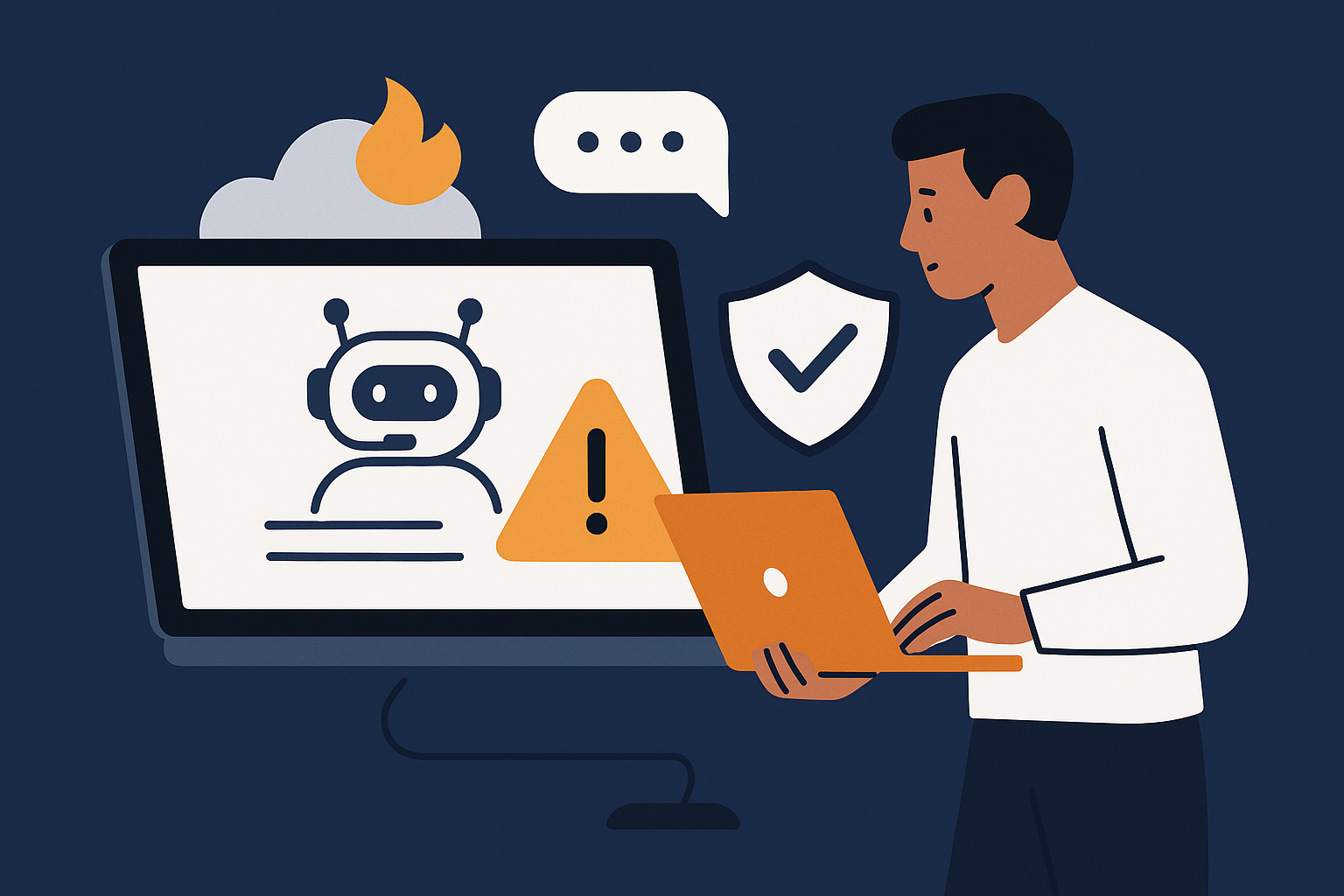Modern web and mobile teams are shipping AI-enhanced features at record speed: natural‑language search, summarization, content generation, decision support. With these gains come unfamiliar failure modes—prompt injection, sensitive data leakage, biased outputs, jailbreaks, model drift after a silent provider update, or a third‑party outage cascading through your stack.
If your organization already has incident management for your platform or enterprise application development, you’re halfway there. But AI/LLM incidents need additional detection signals, kill‑switch mechanics, and audit trails to protect users and the business. This guide gives C‑level leaders, product heads, and engineering managers a concrete, procurement‑ready incident response playbook tailored to AI features—framed to reduce risk, protect revenue, and preserve trust.
Many agencies publish strong content on AI adoption, digital strategy, and design systems; comparatively few dig into the operational “what happens when it breaks?” for AI features embedded in production apps. You’ll find insights on becoming AI‑native and governance readiness, on design sprints, and on enterprise‑scale design systems—but detailed, actionable AI incident response for shipped LLM features remains underrepresented.
Event/Performer Details

Think of an AI incident as an “event,” with a defined cast of “performers” responsible for assessment, mitigation, and communication. For an enterprise‑grade web application or mobile app, define the following roles up front:
- Executive sponsor: Accountable for business risk and public communications.
- Product owner (AI features): Prioritizes user impact, approves feature‑level rollbacks.
- Incident commander (IC): Leads response; rotates on a trained roster.
- AI safety lead: Owns LLM risk taxonomy, guardrails, jailbreak testing, and approvals.
- Engineering lead: Implements mitigations, toggles feature flags, validates rollbacks.
- Data/ML lead: Investigates model behavior, routing, prompts, embeddings, and drift.
- Security & Privacy lead: Handles data exposure, access revocation, regulatory steps.
- Legal & Compliance: Guides obligations (breach, consent, record‑keeping).
- Customer success/Support lead: Coordinates customer messaging and remediation.
- Communications/Marketing: Crafts external statements if needed.
Key artifacts to prepare:
- AI Incident Catalogue: A shared definition set for “AI‑specific” severities (see below).
- Runbooks: Step‑by‑step for each high‑risk scenario (e.g., prompt injection in support bot).
- Kill‑switch matrix: Which flags or routes to disable, per feature and per tenant/region.
- Evidence pack: Log schemas, prompt/response retention rules, model/provider versions, and approval trails to satisfy audits.
Tip: If you already run design sprints and have a design system, extend those assets to include “safety UX” patterns—escalation prompts, confirmations, and user‑visible explanations when AI is temporarily limited.
Why You Shouldn’t Miss It

- Faster time‑to‑mitigation: Minutes matter when generative features misbehave.
- Lower financial exposure: Kill‑switches prevent runaway API spend during loops.
- Compliance posture: Audit‑ready evidence packs speed procurement and renewals.
- Brand protection: Clear playbooks create consistent, trust‑building responses.
- Portfolio resilience: Reusable patterns across web apps, platforms, and mobile apps.
- Buyer confidence: High‑intent prospects vet AI safety in RFPs—this wins deals.
The AI Incident Taxonomy Leaders Can Run
A practical taxonomy separates generic outages from AI‑specific harms. Classify, assign SLAs, and align mitigations.
- Content safety failure
- Example: Model outputs harmful or non‑compliant content despite guardrails.
- Signals: Moderation score spikes, user abuse reports, CSAT drop.
- Default action: Throttle or disable generative responses; degrade to retrieval‑only.
- Data leakage or policy breach
- Example: Response includes sensitive internal data or PII.
- Signals: DLP matches, red‑team alerts, support tickets citing exposure.
- Default action: Kill‑switch on affected flows; rotate credentials; purge affected logs per policy.
- Prompt injection/jailbreak success
- Example: User instructions override system rules to exfiltrate tools or secrets.
- Signals: Sudden tool‑use anomalies, chain‑of‑thought leakage, function misuse.
- Default action: Disable tool use; route to higher‑policy model; patch system prompt.
- Model drift/regression
- Example: Silent provider update changes reasoning or tone; KPIs regress.
- Signals: Conversion or accuracy deltas, spike in “not helpful” feedback.
- Default action: Pin to prior snapshot or fail over to secondary provider.
- Tooling failure or looped autonomy
- Example: Agent loops API calls; cost spike or rate‑limit bans.
- Signals: Spend anomaly, latency surge, repetitive tool patterns.
- Default action: Global tool‑use limiter; turn off autonomous loops; manual review.
Design the Kill‑Switch Like a Product
Kill‑switches must be addressable, granular, and reversible. Treat them as first‑class product capabilities:
- Flagging strategy
- Feature flags per AI capability (summarize, generate, classify, search).
- Tenant/region scoping to respect data residency and minimize blast radius.
- Read‑only degradations: Keep the UI functional without unsafe outputs.
- Provider routing
- Model registry with version pins; explicit rollback targets.
- Secondary model “safe harbor” with stricter policies.
- Health checks and auto‑failover with human approval.
- Cost & rate governance
- Per‑tenant budget caps and method‑level quotas.
- Hard stops on anomalous token usage; alert at 50/80/100% thresholds.
- UX fallbacks
- Transparent messages: “AI features are temporarily limited while we improve safety.”
- Offer human support or manual workflows; capture consent when relevant.
Evidence and Auditability That Win Enterprise Deals
Enterprise buyers increasingly request AI safety and governance proof during vendor selection. Your “AI Evidence Pack” should include:
- Versioned prompts and policies with approval history.
- Model/provider manifests and change logs (date, reason, rollback).
- Moderation pipelines and thresholds; false‑positive/negative tuning notes.
- Red‑team playbooks and results, including jailbreak coverage.
- Data retention maps: prompts, responses, embeddings, vector stores, telemetry.
- Access controls for staff use of AI tooling; privacy controls per region.
- Incident post‑mortems with remediation tracking.
Security and compliance leaders will recognize the parallels with SSDLC and supply‑chain security guidance; extend those frameworks to your AI surface area rather than reinventing. (infinum.com)
Detection: From “It Looks Weird” to Measurable Signals
Instrument AI features with dedicated detection signals:
- Safety signals: Toxicity, self‑harm, hate, personal data patterns, jailbreak classifiers.
- Output quality: Helpfulness ratings, bounce/retry rates, “ask human” deflection.
- Behavior analytics: Tool‑use sequences, abnormal function argument patterns.
- Spend/latency anomalies: Token spikes, cold‑start bursts, provider errors by region.
- Shadow evaluations: Nightly suites with fixed prompts; trend diffs flag regression.
Route signals to an AI‑aware on‑call rotation. Most enterprise application development teams already centralize logging, tracing, and alerting; extend dashboards with an AI panel for fast triage.
Prepare Runbooks You Can Execute at 2 a.m.
For each high‑risk scenario, define a runbook with:
- Triggers: Which metrics or alerts activate the runbook.
- First action: Specific flag to toggle, route to change, or key to revoke.
- Validation: What “green” looks like before re‑enabling.
- Communication: Templates for internal and external updates.
- Evidence capture: Queries to export logs and artifacts for the incident record.
Example: Prompt Injection in Support Assistant
- Trigger: Jailbreak classifier score > threshold on >50 sessions in 10 minutes.
- First action: Disable tool‑use for support assistant; switch to retrieval‑only.
- Containment: Rotate support system API key; patch system prompt; add allowlist tools.
- Validation: Red‑team with known jailbreaks; monitor classifier scores for 1 hour.
- Communication: Status note in app; support macro with timeline and alternatives.
- Evidence: Export prompts/responses, model versions, flags timeline, access logs.
Red‑Team and Tabletop, Quarterly
Don’t wait for production failures. Schedule quarterly AI red‑team exercises and cross‑functional tabletop scenarios. Include:
- Known jailbreak libraries plus adversarial prompts tailored to your domain.
- Tool‑use abuse cases: destructive arguments, path traversal, invoice fraud attempts.
- Data exfiltration drills with synthetic but realistic content.
- Provider outage simulations with failover to backups.
Map each finding to a control: prompt hardening, additional moderation, tooling changes, or UX friction that reduces harm while preserving utility. Several agencies address AI governance at a strategy level; the operationalization through rehearsed incident playbooks is where teams differentiate in 2025. (infinum.com)
Cost Control and ROI When AI Misbehaves
AI incidents can turn into budget incidents—especially with autonomous loops or runaway retries. Build cost containment into your playbooks:
- Pre‑commit budgets per account and per feature; alert at 50/80/100%.
- Transaction‑level circuit breakers (max tokens/output, max retries).
- Shadow “cost‑to‑serve” metric in your product P&L to capture degrade modes.
Tie ROI to resilience:
- Reduced MTTR for AI features correlates with higher conversion and lower churn.
- Fewer escalations free support capacity for revenue work.
- Audit‑ready safety posture shortens enterprise procurement cycles.
Practical Information
- Who it’s for
- CTOs, CIOs, CISOs, VPs of Product, Heads of Design, Platform and Mobile leads.
- What you’ll need
- Feature flagging platform, model registry/config store, observability stack, moderation and jailbreak classifiers, secondary model/provider contracts, and a runbook repository.
- 30‑60‑90 rollout
- 30 days: Inventory AI surface area; write the top 3 runbooks; implement manual kill‑switches; add spend and moderation alerts.
- 60 days: Introduce version‑pinned model routing; build read‑only degradations; ship first red‑team cycle; create evidence pack v1.
- 90 days: Automate circuit breakers; enable regional scoping; rehearse a live tabletop; present “AI Safety & IR” to your exec team.
- Success metrics
- MTTR for AI incidents; percent of AI incidents detected by signals (not tickets); number of features with degradations; audit issues closed; procurement cycle time delta.
- Governance cadence
- Monthly AI Safety Review; quarterly red‑team; biannual audit of prompts/policies and provider versions.
Agencies and enterprises alike have written extensively about AI capability adoption and design system maturity; the response muscle—and what happens in the first 15 minutes—separates resilient digital products from risky ones.
Conclusion
AI will continue to reshape digital product experiences, but trust is earned in how you respond when something goes wrong. By defining roles, codifying an AI‑specific incident taxonomy, engineering reversible kill‑switches, and proving auditability, you turn AI risk into an operational advantage that buyers can measure.
If you’re evaluating a custom web app development agency, seeking MVP development services with compliance needs, or planning enterprise application development with AI in the loop, we can help you design, build, and operate with confidence.
Ready to stress‑test your AI features and ship with resilience? Contact CoreLine’s team today.






